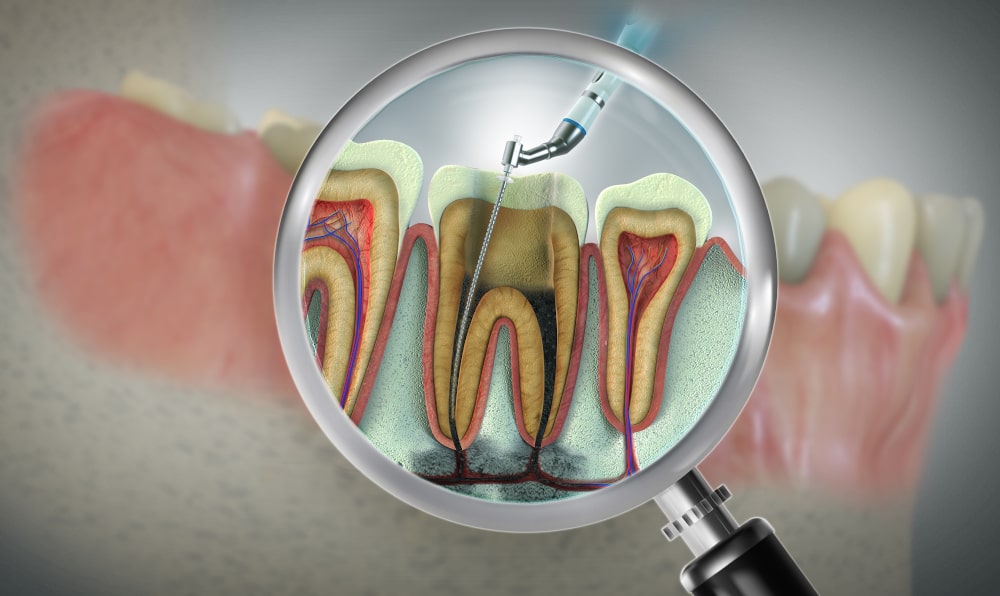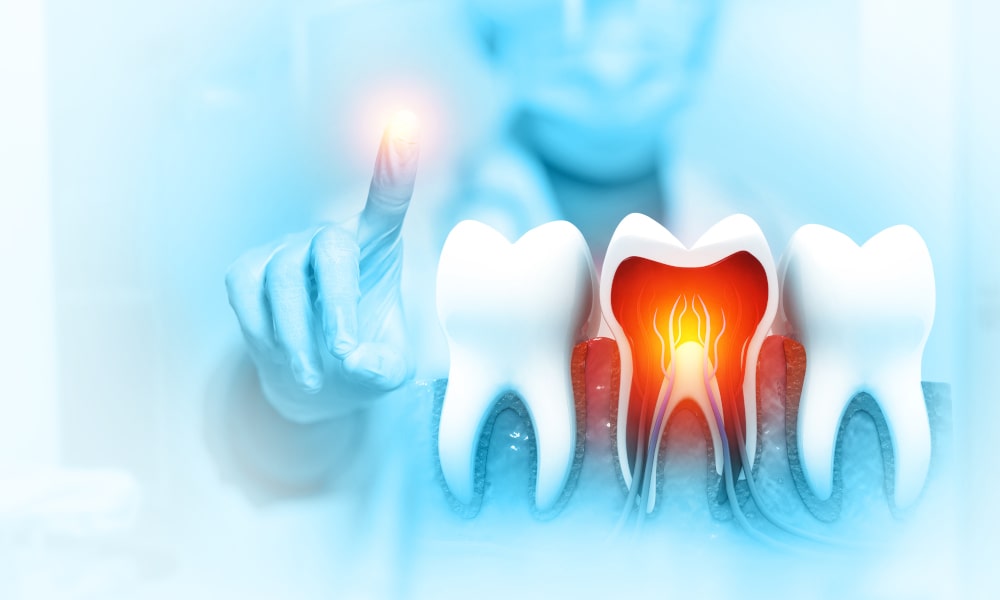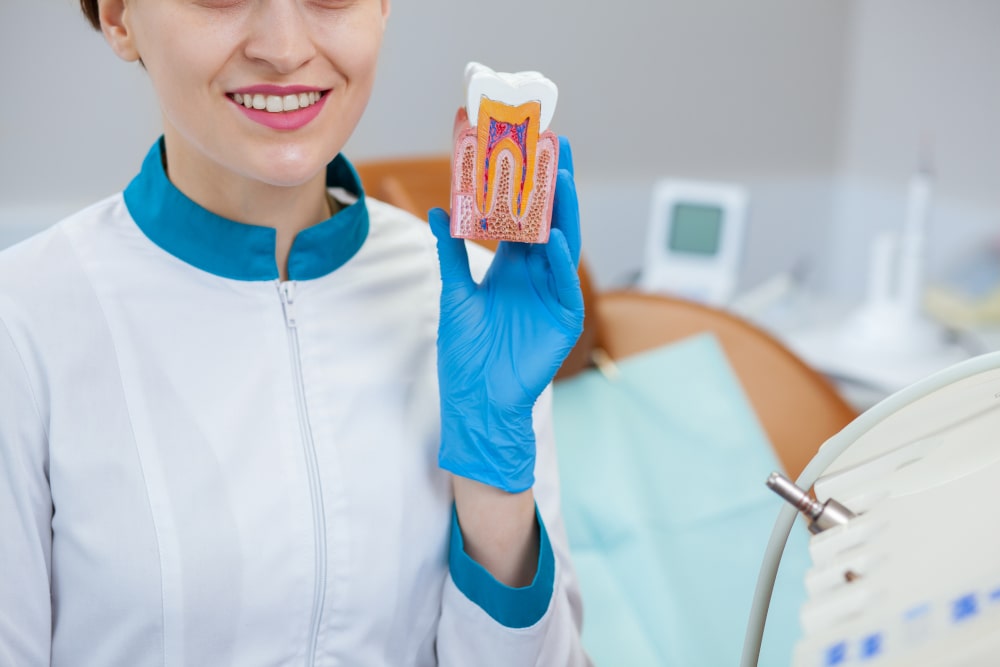
Root Canal Therapy: When It’s Needed and What to Expect
Key Takeaways
- A root canal is a dental procedure that removes infected or damaged pulp from inside a tooth.
- Common causes include deep decay, repeated dental procedures, cracked teeth, or trauma.
- Symptoms that may indicate the need for a root canal include persistent pain, sensitivity, swelling, and discoloration of the tooth.
- The procedure involves cleaning, disinfecting, and sealing the tooth to prevent further infection.
- Timely treatment can save your natural tooth and alleviate severe dental pain.
What exactly is a root canal, and why might you need one?
Imagine biting into something cold and feeling a sharp, lingering pain. Or maybe you’ve had a nagging toothache that just won’t go away. These can be warning signs of a deeper issue — one that might require a root canal.
Understanding the Tooth Anatomy
To understand a root canal, we need to look inside the tooth:
- Enamel is the hard, outer surface.
- Dentin lies beneath the enamel and protects the pulp.
- Pulp is the soft inner core containing nerves, blood vessels, and connective tissue.
When the pulp becomes infected or inflamed due to decay, trauma, or repeated dental procedures, it can cause intense discomfort and increase the risk of further complications.
What Is a Root Canal?
A root canal is a dental treatment that removes infected or damaged pulp tissue from inside the tooth. Once the pulp is removed, the space is cleaned, shaped, disinfected, and filled to prevent further infection.
This treatment allows the natural tooth to be preserved, maintaining functionality while avoiding extraction. According to the Canadian Dental Association (CDA), preserving a natural tooth is almost always preferable to extraction, especially for maintaining proper chewing and alignment.
Common Causes for Needing a Root Canal
- Deep dental decay: Bacteria penetrate deep enough to infect the pulp.
- Cracked or chipped teeth: Even minor fractures can let bacteria in.
- Repeated dental procedures: Excessive drilling or restorations can damage the pulp.
- Facial trauma: A blow to the face can injure the pulp, even without visible cracks.
Quote from the Expert
“A root canal is not a painful procedure—it's the relief from pain. Modern techniques make it as routine as a filling.” — Dr. James C.H. Ko, DDS
Comparison Table: Root Canal vs. Tooth Extraction
| Factor | Root Canal | Tooth Extraction |
|---|---|---|
| Procedure Time | 1–2 appointments | Typically one appointment |
| Pain & Recovery | Mild discomfort post-procedure | Swelling, potential complications |
| Functionality | Maintains natural tooth | Requires replacement (bridge, implant) |
| Long-Term Benefits | Prevents jawbone loss, retains bite | Risk of shifting teeth, bone loss |
In short, a root canal can save a tooth that would otherwise be lost, preserving both function and aesthetics.

What are the most common root canal symptoms to watch for?
People often overlook early signs, attributing them to sensitivity or minor issues. But when ignored, an infection in the tooth pulp can progress rapidly.
Recognizing Key Symptoms
You may need a root canal if you experience:
- Persistent pain: Ongoing or throbbing pain that doesn’t subside.
- Sensitivity to hot or cold: Pain that lingers after the temperature stimulus is removed.
- Swollen gums: Inflammation around the affected tooth.
- Tooth discolouration: A darkening of the tooth due to internal damage.
- Pimple on the gums: This often indicates the formation of an abscess.
- Bad taste or smell: A sign of bacterial activity and pus discharge.
When to See a Dentist
Any combination of these symptoms warrants a prompt dental exam. Early diagnosis can make the difference between saving a tooth and losing it. Delaying treatment may allow the infection to spread, potentially leading to bone loss, increased pain, and the need for more extensive dental procedures.
Don't Rely on Pain Alone
Interestingly, not all root canals are painful. Some teeth may die silently without causing symptoms—until it’s too late. Routine check-ups and dental X-rays are key to early detection.
How is the root canal process performed from start to finish?
Root canal therapy is a systematic, sterile, and highly effective procedure. Let’s walk through the steps to see how it works in a modern dental clinic.
Step 1: Diagnosis and Imaging
- A dentist will examine the tooth and take X-rays to assess the extent of infection.
- Pulp vitality tests help determine if the nerve is alive or necrotic.
Step 2: Anesthesia and Isolation
- Local anesthesia is administered to numb the area.
- A rubber dam is placed around the tooth to keep it dry and free of saliva.
Step 3: Access Opening and Cleaning
- A small opening is drilled into the crown to access the pulp chamber.
- Special tools, like endodontic files, are used to remove the infected tissue.
- The canals are cleaned with antimicrobial irrigants (e.g., sodium hypochlorite).
Step 4: Shaping and Filling
- The canals are shaped to a tapered form and then dried.
- They are filled with gutta-percha, a biocompatible material, and sealed.
Step 5: Temporary or Permanent Restoration
- A temporary filling is placed if another appointment is needed.
- Otherwise, a permanent crown or restoration is done to protect the tooth.
Aftercare and Recovery
- Patients may experience mild soreness for a few days.
- Over-the-counter medications like ibuprofen usually suffice.
- Avoid chewing hard foods until the final crown is placed.
Root canal therapy has evolved significantly. What once had a fearful reputation is now a routine, safe, and effective solution for preserving your smile.
Is a root canal painful during or after the procedure?
Pain is the number one fear associated with root canals, but the reality is far less dramatic. In fact, many patients find the root canal procedure itself is no more uncomfortable than a filling.
Myths vs. Reality
- Myth: Root canals are excruciatingly painful.
- Reality: With modern anesthesia and tools, most patients experience little to no pain during the procedure.
What to Expect During the Procedure
- You’ll be given local anesthesia to numb the area thoroughly.
- Dentists use precision tools to minimize discomfort.
- Patients often feel pressure but no pain.
What About After the Procedure?
Some discomfort is expected once the anesthesia wears off:
- Mild soreness or jaw tenderness for a few days.
- Inflammation occurs as the tissue heals.
- Over-the-counter medication like ibuprofen or acetaminophen typically manages symptoms.
Most patients return to normal activities within 24–48 hours.
Pain Comparison Table
| Procedure | Pain During | Pain After | Recovery Time |
|---|---|---|---|
| Root Canal | Minimal (with anesthetic) | Mild soreness | 1–3 days |
| Filling | Minimal | Rare discomfort | Same day |
| Tooth Extraction | Pressure & tugging | Moderate to severe | Several days to 2 weeks |
How long does a root canal typically take from start to finish?
The duration of a root canal treatment depends on several variables, including the type of tooth, the complexity of the infection, and whether restoration is performed immediately or scheduled for later.
Single vs. Multiple Appointments
- Uncomplicated cases (e.g., front teeth with a single canal) may be completed in a single visit.
- Complex cases (e.g. molars with multiple canals) often require two appointments—one for cleaning and shaping, another for filling and restoration.
Breakdown of Time Per Stage
| Step | Estimated Time |
|---|---|
| Diagnosis & Imaging | 15–30 minutes |
| Anaesthesia & Access | 10–20 minutes |
| Cleaning & Shaping | 30–60 minutes |
| Filling & Sealing | 20–30 minutes |
| Final Restoration | 30–60 minutes (may be a separate appointment) |
Type of Tooth Matters
- Front teeth: 1 canal — faster, often 60–90 minutes.
- Premolars: 1–2 canals — 90–120 minutes.
- Molars: 3–4 canals — 120–180 minutes or more.
What causes a tooth to need a root canal in the first place?
Root canals are necessary when the pulp becomes irreversibly damaged or infected. Let’s look at the main reasons this can occur.
Common Causes
- Deep Tooth Decay: Untreated cavities allow bacteria to invade the pulp chamber.
- Cracked or Fractured Teeth: Even microcracks can expose the pulp.
- Repeated Dental Work: Multiple restorations can cause pulp damage over time.
- Failed Fillings or Crowns: Poorly sealed restorations let bacteria seep in.
- Trauma: A fall or accident can damage the nerve, even if the tooth looks fine.
Graphic Representation (Visual Description)
Imagine this simplified progression:
- Cavities form in enamel.
- Decay spreads through dentin.
- Infection reaches the pulp.
- Pulp inflames and dies.
- Abscess forms at the root tip.
- Bone damage and facial swelling follow.
Conditions Leading to Root Canal
| Condition | How It Harms the Pulp | Common in |
|---|---|---|
| Untreated cavities | Bacteria infect the nerve | Children and adults with poor hygiene |
| Large fillings | Thermal/mechanical stress | Teeth with old restorations |
| Trauma | Internal bleeding/pulp death | Athletes, accident victims |
| Bruxism (grinding) | Hairline cracks | Night grinders, stress sufferers |
What should you expect during root canal recovery?
The hardest part is over once the root canal is completed, but recovery is still a crucial phase. While most people bounce back quickly, understanding the typical timeline and possible discomfort helps manage expectations.
Pain and Swelling Timeline
- First 24–48 hours: Mild to moderate soreness in the area, especially when biting.
- Swelling: Minor gum swelling may occur depending on the level of prior infection.
- Days 3–7: Discomfort should noticeably subside; pain typically responds to OTC medications.
- After one week, Most patients feel completely normal, though healing inside the tooth continues.
Swelling or pain that worsens after 48 hours may signal an issue, such as a residual infection, and should be reported to your dentist.
Realistic Recovery Expectations
- Avoid hard foods and chewing on the treated side for the first few days.
- Temporary crowns may come loose; contact your dentist if this happens.
- Minor bruising around the jaw may occur but is not common.
Keep in mind that complete healing of the bone around the root tip can take several months, even if you feel fine externally.

What can you eat after getting a root canal?
Eating the right foods after treatment can make a significant difference in your recovery and overall comfort. The first 24 hours are critical for avoiding irritation or dislodging any temporary restorations.
First 24 Hours: Best Foods
- Soft fruits (bananas, applesauce)
- Mashed potatoes or cooked vegetables
- Soups (lukewarm, not hot)
- Smoothies (avoid seeds or tricky bits)
- Yogurt or pudding
Avoid anything crunchy, sticky, or extremely hot or cold.
Days 2–7: Gradual Reintroduction
- Scrambled eggs
- Rice or pasta
- Soft meats like fish or shredded chicken
- Oatmeal
Long-Term Diet Considerations
- Stick to a balanced diet rich in calcium and vitamin D to support bone healing.
- Minimize sugar intake to avoid future cavities near the treated tooth.
- Chew on the opposite side until your permanent crown is placed.
Foods to Avoid
- Hard foods (nuts, raw carrots, crusty bread)
- Sticky foods (gum, caramel)
- Very hot or icy drinks (may irritate the area)
- Tough meats or chewy candy
Quick Reference Chart
| Timeframe | Foods to Eat | Foods to Avoid |
|---|---|---|
| First 24h | Yogurt, soup, applesauce | Chips, popcorn, and steak |
| Day 2–7 | Eggs, rice, soft veggies | Nuts, gum, toffee |
| After healing | Balanced soft/firm foods | Overly complex or sticky treats |
What are the risks if you delay a needed root canal?
It’s tempting to put off dental procedures, especially when the pain ebbs temporarily. But delaying a root canal can cause serious consequences, many of which aren’t immediately visible.
What Happens if You Wait Too Long?
- Infection spread: The bacteria can move into nearby bone and tissue.
- Abscess formation: Pus accumulates at the root, creating painful pressure.
- Bone loss: Infection can erode the jawbone around the root.
- Tooth loss: The longer the pulp remains infected, the more likely it is that the tooth will not be lost.
- Systemic impact: In rare cases, the infection can spread to other parts of the body.
Signs You’ve Waited Too Long
- Swelling that spreads to the face or neck
- Persistent bad taste or drainage
- Pain when biting or chewing
- Visible pus or “pimple” near the gum
What happens if a root canal fails?
Signs That a Root Canal Has Failed
- Persistent or returning pain
- Swelling or tenderness in the gums near the treated tooth
- Discolouration of the tooth after recovery
- Pimple-like bump (gum boil) near the tooth
- Sensitivity to pressure when chewing
Sometimes the symptoms are subtle, while at other times they are unmistakably painful.
Common Reasons for Failure
- Missed canals during the original procedure
- Incomplete removal of infected tissue
- New decay compromising the seal
- Cracked crown or tooth, allowing bacteria in
- Delayed crown placement, exposing the tooth to reinfection
Retreatment Options
- Endodontic Retreatment: The original filling is removed, canals are cleaned again, and a new filling is placed.
- Apicoectomy: Surgical removal of the root tip and surrounding tissue if reinfection persists.
- Extraction and Replacement: If the tooth is beyond saving, it may be removed and replaced with a bridge or implant.
When to See an Endodontist
Endodontists are root canal specialists. If symptoms recur or complications arise, it’s often best to:
- Request a cone-beam CT scan to detect hidden canals or cracks.
- Consult an endodontist for second opinions or surgical options.
Delays in addressing a failing root canal can lead to bone loss and systemic infection. Prompt action makes all the difference.
How do you care for your tooth after a root canal?
Proper care after a root canal greatly improves the chances of long-term success. Here's a guide to help you protect your investment.
Step-by-Step Post-Treatment Care
- Avoid chewing on the treated side until fully restored.
- Brush gently around the area, but continue brushing twice daily.
- Use a soft-bristled toothbrush to reduce irritation.
- Floss daily, especially around the crown once it has been placed.
- Rinse with warm salt water for the first few days if the gums feel tender.
The Role of the Crown
Most root canal-treated teeth — especially molars — need a crown to:
- Protect against fracture
- Seal the tooth from future bacterial contamination
- Restore full chewing function
It’s best to place a permanent crown within 1–2 weeks of the root canal to avoid complications.
Follow-Up Visits
- 1st follow-up: Your dentist may assess healing a week or two after the procedure.
- Crown placement: Usually within two weeks.
- Routine checkups: Every 6–12 months for monitoring.
What’s the bottom line on root canals?
Root canals save millions of teeth each year — and thanks to modern techniques, they are far less intimidating than many people assume. If you’re dealing with dental pain, avoiding treatment may cost you far more than facing it.
Recap of Key Points
- Root canals remove infected pulp and seal the tooth to prevent further infection.
- They’re performed under anesthesia and typically cause minimal pain.
- Recovery is quick and straightforward for most people.
- Timely crowns and oral hygiene are essential to long-term success.
- Delaying treatment can lead to serious complications.
Root Canal Insights
| Topic | Key Takeaway |
|---|---|
| Pain | Mostly mild; anesthesia used |
| Duration | 1–2 visits, depending on tooth complexity |
| Diet | Soft foods initially; avoid hard/sticky items |
| Risk of Delay | Bone loss, infection, and tooth loss |
| Aftercare | Crown placement, daily hygiene, routine checkups |
Sources Used
- Canadian Dental Association: https://www.cda-adc.ca
- American Association of Endodontists: https://www.aae.org
- Academy of Nutrition and Dietetics: https://www.eatright.org
- Journal of Endodontics: https://www.jendodon.com
- Cleveland Clinic: https://my.clevelandclinic.org/health/treatments/21759-root-canal

See what our patients are saying:
The Barrie Smile Centre is the best dental office I've ever been to. The staff is very friendly,professional and knowledgeable. They take away any anxiety and fear of going for a procedure. I highly recommend them!
Very clean, professional and friendly! They have done lots of work for me including 2 implants. I highly recommend them!
Very clean, professional and helpful. 2 other dentists previously tried to fix my composite veneer and both times it look awful and/or was the wrong colour. One trip here and everything was fixed!
Very friendly, helpful staff. Makes you feel welcome as soon as you enter. I needed a tooth removed and got in the same day I called. When I arrived I didn’t have to wait. I have numerous problem with my teeth and they came up with a solution. Thank you all so much.
Just got home from the Smile Centre and I'm thrilled with my results. Had Zoom whitening, and it was better than I expected. The attendant took the time to explain everything super thoroughly. She warned I may have sensitivity but so far so good. I wish I did it ages ago.
The first thing I noticed upon entering the building was the beautiful design plan and lovely staff. I was greeted at the door and made comfortable throughout my entire experience. Everything was explained to me in detail and the staff always made sure I fully understood. This is an amazing office and I would 10/10 recommend it!!
Amazing fast clean attentive friendly ! Im sold! Thankkk youuuuu guys !!!!!!! Had a wisdom.tooth taken out under sedation! All.went perfect and you guys were awesomee!
Every time I go to the Smile Centre in Barrie it’s an amazing experience! Everyone from the admin staff to the dentists are so helpful. Not only do they tell you your options (in my case options for a missing tooth), but they also explain the pros and cons of every option. I highly recommend the Smile Centre
Barrie Smile Centre is truly amazing I called and had an issue with with some tooth pain they were able to fit me in same day which I was truly grateful for. All the staff are kind and professional they truly care about there patients. Big thank you to Dr.Eisen for being so kind and helping me in this situation. I highly recommend Barrie Smile Centre 😃 Thanks again
Great family dentist, has always been on time for appointments. Doing a great job during these times with cleanliness as well! Very professional staff!

